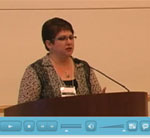Regina Job Search Strategies Forum Report
Tips on Preparing for Interviews: What Recruiters Look For
| Video |
 |
Suzanne Orieux-Koroluk, District People Manager, Saskatchewan, Walmart Canada
Suzanne Orieux-Koroluk thanked Dillon for the opportunity to attend the forum, not just to provide tips but also to network and meet people.
Orieux-Koroluk is responsible for all human resource functions at Walmart’s 14 Saskatchewan stores. She has experience interviewing thousands of people. Walmart has 312 stores across Canada, and employs 82,000 people.
“We certainly believe that diversity is about creating a culture of inclusion that encourages the unique qualities of each associate, and celebrating how our differences bring value to our customers and to our workplace,” she said.
When preparing for an interview, applicants should first identify what they want to do, and then find out what the company is about. “If that company doesn’t fit for you, it won’t be a good place to work, even if you have the skill set, and even if you have the education,” she said.
Applicants should also understand what the available position entails. “We can go through life just working or we can go through life loving what we do,” said Orieux-Koroluk. Applicants must know their value, and should communicate their salary expectations without selling themselves short.
Prepare for the interview by rehearsing: practice answering questions. Google is a great tool to research the type of questions that might be asked. Have friends and family ask questions and provide feedback; mock interviewing will help settle an applicant’s nerves.
Applicants should know their resumés and understand how their experience is relevant to the job they are applying for, and they should prepare questions to ask the interviewer. At the end of the interview, employers typically ask candidates if they have any questions. If an applicant has researched the company, some questions should come to mind. Leaving the interview without asking questions could mean one of two things: the interviewer has answered all the questions the applicant might have had, or the applicant has not done any research.
Bring a resumé and list of references to the interview, and be sure to verify the references’ contact information beforehand. Planning ahead is important. Dress appropriately for the position, and also for the company culture. Applicants should ask about the dress code when they are called for an interview.
“Remember to present yourself neat and tidy,” said Orieux-Koroluk.
Being on time is absolutely critical. Be 10–15 minutes early, but not an hour early. Figure out how long it will take to get to the interview using whatever mode of transportation you plan to take on the day of the interview. Know what type of interview is planned and who will be interviewing you. Use the person’s name upon meeting and throughout the interview.
There are a number of different types of interviews:
- An exploratory interview involves one-sided questions that require direct answers.
- A behavioural interview requires applicants to illustrate their answers using their own experience, and not hypothetical situations.
- A scenario-based interview involves hypothetical situations that require applicants to explain how they would manage the outcome or provide a solution.
- A panel interview involves questions from several interviewers.
- A group interview includes several candidates, and might involve role-playing or team activities. The employer will observe the applicants’ behaviour and their reactions to different situations.
Interviews can be unstructured or structured. The unstructured interview might involve the interviewer talking a lot about the company, or about themselves. The structured interview is better, and would fall into one of the categories listed above. Orieux-Koroluk said participants should ask what type of interview to expect.
When answering questions in a behavioural interview, Orieux-Koroluk suggested using the STAR strategy:
- Situation: Explain the situation you were faced with.
- Task: Identify the problem, or change required.
- Action: Explain what action you took to address the problem.
- Result: Share the outcome and explain what you accomplished.
This method will ensure the applicant has covered all of the aspects the interviewer is looking for.
Employers are looking for a candidate who shows interest in the company and the position, and who meets the company’s needs. They want to see someone who is adequately prepared for the interview, is engaged in the process, and demonstrates confidence and an understanding of self-value. Applicants should treat everyone positively, from the person who set up the interview to the person who greets them at the door.
Orieux-Koroluk said there are five opportunities to disclose a disability: the job application, the interview, after the job offer, after beginning work, and if a problem exists in the workplace.
“The only logical reason to disclose is if you need to request a reasonable accommodation from your employer to perform an essential function of the job,” she said.

 Quick Question:
Quick Question:

